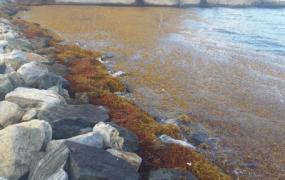Press Release
 The seasonal floating weed, known as Sargassum Seaweed has returned and has increased in indefinite amounts.
The seasonal floating weed, known as Sargassum Seaweed has returned and has increased in indefinite amounts.
The floating brown seaweed is a marine algae that originates from the Sargasso Sea which is a region in the Gyre of the North Atlantic Ocean.
Persons and communities who are interested in cleaning coastal areas that may have large amounts of seaweed, are asked to wait two to three weeks before doing so, to allow for marine life, especially crabs and turtles to depart the weed before full decay.
Acting Deputy Chief Conservation and Fisheries Officer, Mr. Mervin Hastings said there are advantages and disadvantages to the incoming seaweed.
“The disadvantage is that there is typically an offensive smell which may resemble that of rotting eggs given off by the decaying seawead. This is the chemical hydrogen sulphide which may be an irritant to sensitive persons, who should avoid close contact.”
Mr. Hastings also said that the advantage of having nearby Sargassum Seaweed, out in the ocean, is that it provides a floating nursery for ample wildlife similar to a mangrove system. Seaweed helps to restore or build back beaches, in turn creating greater coastal protection and storm resilience.
Officials at the Ministry of Natural Resources and Labour and the Conservation and Fisheries Department are also cautioning persons against collecting the seaweed while it is still afloat in the ocean.
The Sargassum Seaweed is found on beaches and shorelines throughout tropical areas worldwide and undergoes seasonal cycles of growth and decay due to changes in sea temperature that may or may not be attributed to Climate Change.
The seaweed, once collected can be made into compost when the salt has been washed out or sent to the incinerator for disposal.
For more information on the Sargassum Seaweed and beach cleaning efforts, please contact the Conservation and Fisheries Department at 468-2700.

